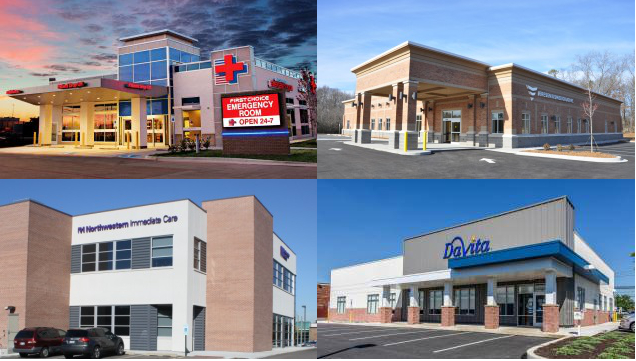
CHICAGO—The single tenant medical sector remained popular with investors through the first three quarters of 2016, and several demographic factors will likely sustain that interest over the next few years, regardless of changes in the nation's political landscape.
Transactions in the sector, specifically among medical assets priced under $10 million, were up about 8% when compared to the first three quarters of 2015, according to a new report from The Boulder Group, a single tenant net lease firm in suburban Chicago. In the same time period, the number of transactions in the overall net lease market was down 2.6%. And the median asking cap rate for medical properties remained unchanged at 6.5%.
The third quarter, of course, ended before the political earthquake of Nov. 8. And just like observers of every commercial real estate sector, analysts of the net lease market are carefully watching to see how it responds to the transformation.
“I have not seen any investor changes in the net lease medical sector since the Trump election, but it has only been a few weeks, and many participants are taking a wait and see attitude,” Randy Blankstein, president of Boulder, tells GlobeSt.com.
However, big portions of this market will probably see an increase in patient demand and interest from investors. The dialysis sector, for example, now has a median asking cap rate of 6.38%, lower than urgent care and general doctor properties and a compression of 22 bps over 2015, Boulder found.
“Dialysis is growing due to a aging population and America's current obesity issue,” Blankstein says, “and thus will likely expand despite some short-term uncertainty with Obamacare.”
Investors find these clinics, which made up 57% of the overall net lease medical sector, attractive for many reasons. They typically have strong corporate guarantees and familiar tenants such as Fresenius and DaVita. And the lower price points associated with dialysis properties have garnered interest from 1031 buyers who traditionally purchase net lease retail assets. The median price for net lease dialysis properties in the third quarter of 2016 was about $2.4 million, or about $1 million less than the overall net lease medical sector.
The net lease medical sector as a whole has a number of built-in strengths. The aging of the country's population will keep boosting demand for all types of medical properties. And unlike other retail, e-commerce can't undercut medical properties. Furthermore, most medical leases feature rental escalations, an attribute highly sought after by net lease investors.
The overall net lease market experienced cap rate compression of 36 bps from the third quarter of 2015 to the third quarter of 2016. Boulder attributes the lack of any change in the medical sector to the influx of non-investment grade medical properties. In the third quarter of 2016, there was a 26% increase in the supply of non-investment grade medical properties, which typically trade at a discount. Furthermore, non-investment grade medical properties made up 65% of the net lease medical sector.
In order to meet the needs and demands of the changing healthcare industry, real estate professionals need to adapt their strategies to new circumstances. Join us at RealShare Healthcare Real Estate on Dec. 7 and 8 for insights on succeeding in both the right markets and product types as well as navigating and finding opportunities in the more challenging ones. Learn more.

CHICAGO—The single tenant medical sector remained popular with investors through the first three quarters of 2016, and several demographic factors will likely sustain that interest over the next few years, regardless of changes in the nation's political landscape.
Transactions in the sector, specifically among medical assets priced under $10 million, were up about 8% when compared to the first three quarters of 2015, according to a new report from The Boulder Group, a single tenant net lease firm in suburban Chicago. In the same time period, the number of transactions in the overall net lease market was down 2.6%. And the median asking cap rate for medical properties remained unchanged at 6.5%.
The third quarter, of course, ended before the political earthquake of Nov. 8. And just like observers of every commercial real estate sector, analysts of the net lease market are carefully watching to see how it responds to the transformation.
“I have not seen any investor changes in the net lease medical sector since the Trump election, but it has only been a few weeks, and many participants are taking a wait and see attitude,” Randy Blankstein, president of Boulder, tells GlobeSt.com.
However, big portions of this market will probably see an increase in patient demand and interest from investors. The dialysis sector, for example, now has a median asking cap rate of 6.38%, lower than urgent care and general doctor properties and a compression of 22 bps over 2015, Boulder found.
“Dialysis is growing due to a aging population and America's current obesity issue,” Blankstein says, “and thus will likely expand despite some short-term uncertainty with Obamacare.”
Investors find these clinics, which made up 57% of the overall net lease medical sector, attractive for many reasons. They typically have strong corporate guarantees and familiar tenants such as Fresenius and DaVita. And the lower price points associated with dialysis properties have garnered interest from 1031 buyers who traditionally purchase net lease retail assets. The median price for net lease dialysis properties in the third quarter of 2016 was about $2.4 million, or about $1 million less than the overall net lease medical sector.
The net lease medical sector as a whole has a number of built-in strengths. The aging of the country's population will keep boosting demand for all types of medical properties. And unlike other retail, e-commerce can't undercut medical properties. Furthermore, most medical leases feature rental escalations, an attribute highly sought after by net lease investors.
The overall net lease market experienced cap rate compression of 36 bps from the third quarter of 2015 to the third quarter of 2016. Boulder attributes the lack of any change in the medical sector to the influx of non-investment grade medical properties. In the third quarter of 2016, there was a 26% increase in the supply of non-investment grade medical properties, which typically trade at a discount. Furthermore, non-investment grade medical properties made up 65% of the net lease medical sector.
In order to meet the needs and demands of the changing healthcare industry, real estate professionals need to adapt their strategies to new circumstances. Join us at RealShare Healthcare Real Estate on Dec. 7 and 8 for insights on succeeding in both the right markets and product types as well as navigating and finding opportunities in the more challenging ones. Learn more.
© Touchpoint Markets, All Rights Reserved. Request academic re-use from www.copyright.com. All other uses, submit a request to [email protected]. For more inforrmation visit Asset & Logo Licensing.








